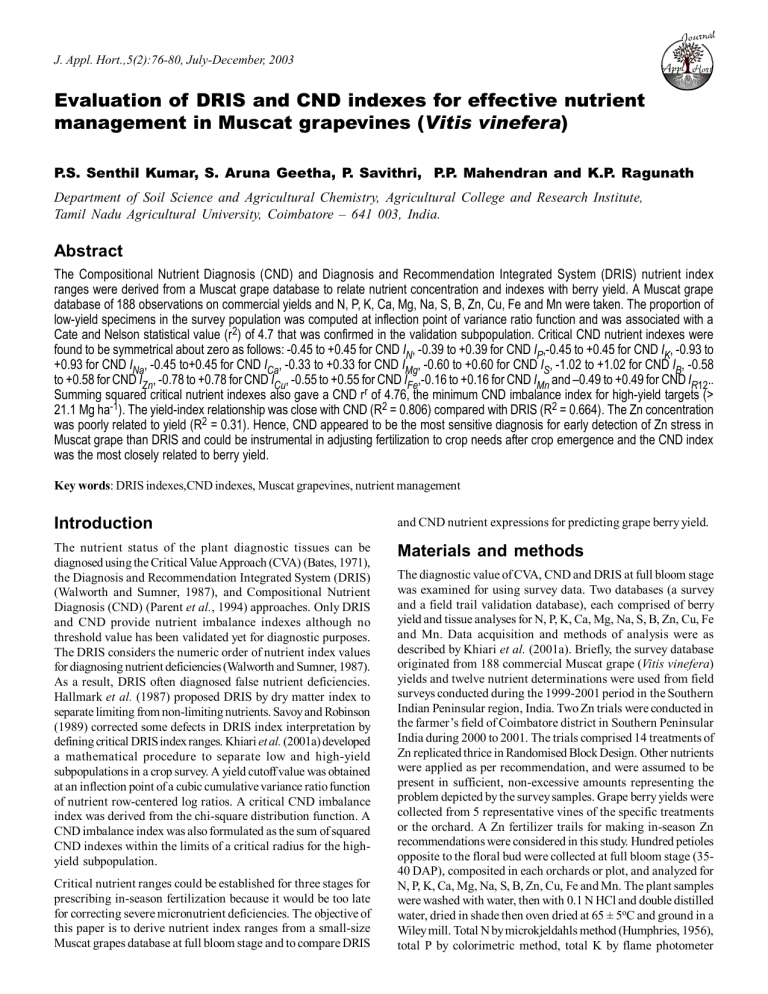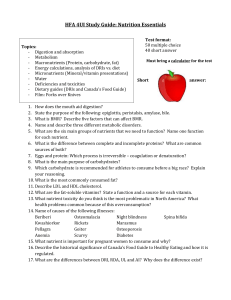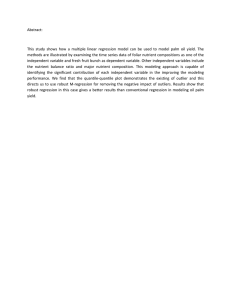
J. Appl. Hort.,5(2):76-80, July-December, 2003 Evaluation of DRIS and CND indexes for effective nutrient management in Muscat grapevines (Vitis vinefera) P.S. Senthil Kumar, S. Aruna Geetha, P. Savithri, P.P. Mahendran and K.P. Ragunath Department of Soil Science and Agricultural Chemistry, Agricultural College and Research Institute, Tamil Nadu Agricultural University, Coimbatore – 641 003, India. Abstract The Compositional Nutrient Diagnosis (CND) and Diagnosis and Recommendation Integrated System (DRIS) nutrient index ranges were derived from a Muscat grape database to relate nutrient concentration and indexes with berry yield. A Muscat grape database of 188 observations on commercial yields and N, P, K, Ca, Mg, Na, S, B, Zn, Cu, Fe and Mn were taken. The proportion of low-yield specimens in the survey population was computed at inflection point of variance ratio function and was associated with a Cate and Nelson statistical value (r2) of 4.7 that was confirmed in the validation subpopulation. Critical CND nutrient indexes were found to be symmetrical about zero as follows: -0.45 to +0.45 for CND IN, -0.39 to +0.39 for CND IP,-0.45 to +0.45 for CND IK, -0.93 to +0.93 for CND INa, -0.45 to+0.45 for CND ICa, -0.33 to +0.33 for CND IMg, -0.60 to +0.60 for CND IS, -1.02 to +1.02 for CND IB, -0.58 to +0.58 for CND IZn, -0.78 to +0.78 for CND ICu, -0.55 to +0.55 for CND IFe,-0.16 to +0.16 for CND IMn and –0.49 to +0.49 for CND IR12.. Summing squared critical nutrient indexes also gave a CND rr of 4.76, the minimum CND imbalance index for high-yield targets (> 21.1 Mg ha-1). The yield-index relationship was close with CND (R2 = 0.806) compared with DRIS (R2 = 0.664). The Zn concentration was poorly related to yield (R2 = 0.31). Hence, CND appeared to be the most sensitive diagnosis for early detection of Zn stress in Muscat grape than DRIS and could be instrumental in adjusting fertilization to crop needs after crop emergence and the CND index was the most closely related to berry yield. Key words: DRIS indexes,CND indexes, Muscat grapevines, nutrient management Introduction and CND nutrient expressions for predicting grape berry yield. The nutrient status of the plant diagnostic tissues can be diagnosed using the Critical Value Approach (CVA) (Bates, 1971), the Diagnosis and Recommendation Integrated System (DRIS) (Walworth and Sumner, 1987), and Compositional Nutrient Diagnosis (CND) (Parent et al., 1994) approaches. Only DRIS and CND provide nutrient imbalance indexes although no threshold value has been validated yet for diagnostic purposes. The DRIS considers the numeric order of nutrient index values for diagnosing nutrient deficiencies (Walworth and Sumner, 1987). As a result, DRIS often diagnosed false nutrient deficiencies. Hallmark et al. (1987) proposed DRIS by dry matter index to separate limiting from non-limiting nutrients. Savoy and Robinson (1989) corrected some defects in DRIS index interpretation by defining critical DRIS index ranges. Khiari et al. (2001a) developed a mathematical procedure to separate low and high-yield subpopulations in a crop survey. A yield cutoff value was obtained at an inflection point of a cubic cumulative variance ratio function of nutrient row-centered log ratios. A critical CND imbalance index was derived from the chi-square distribution function. A CND imbalance index was also formulated as the sum of squared CND indexes within the limits of a critical radius for the highyield subpopulation. Materials and methods Critical nutrient ranges could be established for three stages for prescribing in-season fertilization because it would be too late for correcting severe micronutrient deficiencies. The objective of this paper is to derive nutrient index ranges from a small-size Muscat grapes database at full bloom stage and to compare DRIS The diagnostic value of CVA, CND and DRIS at full bloom stage was examined for using survey data. Two databases (a survey and a field trail validation database), each comprised of berry yield and tissue analyses for N, P, K, Ca, Mg, Na, S, B, Zn, Cu, Fe and Mn. Data acquisition and methods of analysis were as described by Khiari et al. (2001a). Briefly, the survey database originated from 188 commercial Muscat grape (Vitis vinefera) yields and twelve nutrient determinations were used from field surveys conducted during the 1999-2001 period in the Southern Indian Peninsular region, India. Two Zn trials were conducted in the farmer’s field of Coimbatore district in Southern Peninsular India during 2000 to 2001. The trials comprised 14 treatments of Zn replicated thrice in Randomised Block Design. Other nutrients were applied as per recommendation, and were assumed to be present in sufficient, non-excessive amounts representing the problem depicted by the survey samples. Grape berry yields were collected from 5 representative vines of the specific treatments or the orchard. A Zn fertilizer trails for making in-season Zn recommendations were considered in this study. Hundred petioles opposite to the floral bud were collected at full bloom stage (3540 DAP), composited in each orchards or plot, and analyzed for N, P, K, Ca, Mg, Na, S, B, Zn, Cu, Fe and Mn. The plant samples were washed with water, then with 0.1 N HCl and double distilled water, dried in shade then oven dried at 65 ± 5oC and ground in a Wiley mill. Total N by microkjeldahls method (Humphries, 1956), total P by colorimetric method, total K by flame photometer DRIS and CND indexes in Muscat grapevines The DRIS norms and indexes were computed according to Walworth and Sumner (1987), and the CND norms and indexes via the computation steps of Khiari et al. (2001a). The CateNelson ANOVA procedure (Nelson and Anderson, 1977) was used to partition yield data between two groups by maximizing the between-groups sums of squares to determine the threshold values for CND indexes required to compute the critical CND r2 value. We used 188 observations for developing the nutrient norms and a field experiment was conducted and the observations were used in the database for validating the norms. The concentration, DRIS and CND nutrient expressions were related to one another by regression analysis. A software named “Soil and Plant Nutrient Diagnoser (SPND)” for all statistical computations of DRIS, CND was developed in Microsoft Visual FOXPRO 97 and Microsoft EXCEL (Microsoft, 1997). Using this software the various computations involved in the two diagnostic approaches were done. Results and discussion Selection of a high-yield subpopulation from the survey database (n=188): The cutoff yield between the low and high-yield subpopulations were determined using Cate-Nelson partitioning procedure which was reported to be significantly close in critical values of CND mathematical approach in a validation study (Khiari et al., 2001b). Highest cutoff yield was obtained with 21.1 Mg/ha and was thus used to separate the low- and high-yield subpopulations. The high-yield specimens accounted for 88 of 188 specimens in the survey population. That yield cutoff value, corresponding to the minimum yield target for separating the low- and high-yield subpopulations, was lower than yield targets proposed by Bhargava and Raghupathi (1996, 1997) for other 35 2 Y=0.2373x + 5.43x + 40.20 R2 = 0.98 30 Yield goal (Mg/ha) method, total Ca and Mg by versanate method, total Na by flame photometer method (Piper, 1966), total S by turbidimetric method (Chesnin and Yien, 1950), total B by colorimetric method (Page et al., 1982) and total micronutrient by atomic absorption spectrophotometric method (Piper, 1966) after wet digesting the tissues in a mixture of HNO3 and HClO4 (Barnhisel and Bertsch, 1982) was done. Total Muscat grape yield was recorded from the five representative plants taken for individual treatments and in 1 x 3-m long rows in production orchards, depending on field dimension and soil variability. 77 25 20 15 10 5 0 0.0 1.0 2.0 3.0 4.0 5.0 6.0 7.0 8.0 Chi-square Fig. 1. Theoretical relationship between berry yield goal and the chi square value grapevines varieties. The nutrient concentrations of the highyield subpopulation above yield cutoff were used to generate the DRIS and CND norms (Table 1 ). The CND norms derived from the high-yield subpopulation: The survey population comprised 100 yield data points below and 88 above cutoff yield value of 21.1 Mg/ha berry. Hence the proportion of low-yield specimens was 100:188, or 53.2 %. As expected from DRIS graphs relating nutrient expressions to yield (Walworth and Sumner, 1987), higher yield targets would increase the proportion of low-yield specimens in a population and produce narrower critical nutrient ranges. For example, the proportion of low-yield specimens for a yield target of 25.0 Mg/ha berry would be 74.5 %, and the corresponding chi-square value is close to 3.4 (Fig 1). For a yield goal of 30 Mg/ha berry, the chi-square value would be 1.9. Hence, as CND r2 gets smaller and yield goal gets higher, critical nutrient index ranges must also become narrower to keep the sum of squared critical nutrient indexes equal to CND r2. Validation of the threshold nutrient imbalance index: The S12, i.e., thirteen-dimensional (d+1) Muscat grape simplex comprised the twelve nutrients N, P, K, Ca, Mg, Na, S, B, Zn, Cu, Fe and Mn and the filling value R12. Nutrient concentrations were transformed into CND row-centered log ratios VN, VP, VK, VCa, VMg, VNa, VS, VB, VZn, VCu, VFe and VMn. The CND norms as means and standard deviations of VN, VP, VK, VCa, VMg, VNa, VS, VB, VZn, VCu, VFe, VMn and VR13 and CND r2 were computed as linearized, standardized variables (Khiari et al., 2001a). The CND norms are the means Table 1. New foliar diagnostic reference norms for nutrient concentration in petiole of Muscat grapes Nutrients Diagnosis and Recommendation Integrated System (DRIS) Compositional Nutrient Diagnosis (CND) Critical CV Deficiency Optimum Excess Critical CV Deficiency Optimum Excess value value N (%) 2.00 40.5 < 0.92 0.93 – 3.07 > 3.08 1.86 29.0 < 1.14 1.15 – 3.02 > 3.03 P (%) 0.73 38.4 < 0.36 0.37 – 1.09 > 1.10 0.67 59.7 < 0.37 0.38 – 1.18 > 1.19 K (%) 2.51 29.9 < 1.50 1.51 – 3.50 > 3.51 2.42 36.0 < 1.63 1.64 – 3.57 > 3.58 Ca (%) 1.63 19.6 < 1.20 1.21 – 2.05 > 2.06 1.61 20.5 < 1.26 1.27 – 2.04 > 2.05 Mg (%) 0.40 42.5 < 0.17 0.18 – 0.62 > 0.63 0.37 48.6 < 0.22 0.23 – 0.61 > 0.62 Na (%) 0.27 37.0 < 0.14 0.15 – 0.39 > 0.40 0.25 60.0 < 0.14 0.15 – 0.45 > 0.46 S (%) 0.60 36.7 < 0.31 0.32 – 0.88 > 0.89 0.56 53.6 < 0.32 0.33 – 0.95 > 0.96 B (mg kg-1) 215.00 20.5 < 156.00 156 – 273 > 274 2110 28.5 < 153 153.5 – 291 > 291 Zn (mg kg-1 71.20 37.2 < 35.85 35.9 – 106 > 107 64.0 69.7 < 33.3 33.4 – 123 > 124 Cu (mg kg-1) 120.00 31.3 < 70.34 70.4 – 169 > 170 114.0 48.2 < 69.1 69.2 – 187 > 187 Fe (mg kg-1) 617.00 34.2 < 336.00 337 – 897 > 898 587.0 36.8 < 394 395 – 874 > 875 Mn (mg kg-1) 76.80 48.0 < 27.70 27.8 – 125 > 126 68.0 79.7 < 33.3 33.4 - 139 > 140 78 DRIS and CND indexes in Muscat grapevines Table 2. Critical Compositional Nutrient Diagnosis (CND) indexes in the validation samples using Cate-Nelson Partitioning procedure for Muscat grapes CND Critical Critical R2* Critical limit index range value yield Lower Upper Mg ha-1 I N2 0.30 19.8 0.08 -0.45 +0.45 IP2 0.26 19.5 0.26 -0.39 +0.39 IK2 0.30 22.6 0.12 -0.45 +0.45 ICa2 0.62 21.0 0.19 -0.93 +0.93 IMg2 0.30 22.4 0.20 -0.45 +0.45 INa2 0.22 19.8 0.28 -0.33 +0.33 IS2 0.40 22.1 0.18 -0.60 +0.60 IB2 0.68 21.1 0.20 -1.02 +1.02 IZn2 0.39 21.8 0.18 -0.58 +0.58 ICu2 0.52 22.7 0.06 -0.78 +0.78 IFe2 0.37 19.6 0.13 -0.55 +0.55 IMn2 0.11 21.1 0.09 -0.16 +0.16 I R2 0.33 20.2 0.18 -0.49 +0.49 Sum 4.70 19.5 0.29 0.00 4.76 (CND r2) * R2 computed following the Cate-Nelson analysis of variance procedure Nutrient sufficiency ranges: The squared values of CND nutrient indexes (Ix) were related to berry yield for partitioning the population according to the Cate-Nelson procedure. Critical values were found to be r2 = IN2 + IP2 + IK2 + ICa2 + IMg2 + INa2 + IS2 + IB2 + IZn2 + ICu2 + IFe2 + IMn2 + IR2 = 0.30+0.26+0.30+0.62+0.30+0.22+0.40+0.68+0.39+0.52+0.37+0.11+0.33 = 4.70 The squared critical CND indexes are additive to make a critical CND r2, the squared critical CND indexes could be used to define critical index ranges symmetrical about zero. The squared individual nutrient indexes must add to the critical CND r2 from theoretical considerations (Khiari et al., 2001a). The critical CND r 2 value thus provides a bounded-sum constraint to the combination of nutrient ranges as defined by the Cate-Nelson procedure and can be used as a control procedure. This could not be obtained with DRIS. The critical CND nutrient index ranges were as follows: -0.45 to +0.45 for CND IN, -0.39 to +0.39 for CND IP,-0.45 to +0.45 for CND IK, -0.93 to +0.93 for CND INa, -0.45 to+0.45 for CND ICa, -0.33 to +0.33 for CND IMg, -0.60 to +0.60 for CND IS, -1.02 to +1.02 for CND IB, -0.58 to +0.58 for CND IZn, -0.78 to +0.78 for CND ICu, -0.55 to +0.55 for CND IFe,-0.16 to +0.16 for CND IMn and –0.49 to +0.49 for CND IR12. Those sufficiency ranges for Zn and B were ascertained using Micronutrient fertilizer trails. The CND nutrient ranges appeared to be crop specific because the Muscat grapes nutrient ranges were different than those derived for sweet corn (Khiari et al., 2001b) and for potato (Khiari et al., 2001c). Adopting a nutrient range diagnostic approach, the more distant from the critical range a nutrient would be, the more limiting the nutrient. These approach contrasts with the DRIS nutrient index interpretation using the relative importance of a given nutrient, i.e., the numerical order of nutrient indexes (Walworth and Sumner, 1987). Our results support the view that nutrient ranges should be defined for CND, as was also suggested for DRIS (Savoy and Robinson, 1989 and Khiari et al., 2001c). and standard deviations of row-centered log ratios from the highyield subpopulation (Table 1). The DRIS norms are the mean and coefficient of variation of dual ratios. In the population, yield decreased with increasing CND r2 or DRIS nutrient imbalance index (Fig 2). The same pattern was shown by Walworth and Sumner (1987) between the sum of DRIS indexes, irrespective of sign and yield of sugarcane (Saccharum officinarum L.) and by Khiari et al. (2001a) for potato. The yield-CND r2 and yield-DRIS NII relationship was iterated following the Cate-Nelson ANOVA procedure for separating the low- and high-yielding subpopulations. The critical CND r2 value was found to be 3.8, which corresponded to a yield cutoff value of 22.5 Mg / ha. The critical DRIS nutrient imbalance index corresponded to a yield cutoff of 21.3 Mg / ha. However, using the Cate-Nelson partitioning procedure, DRIS was less effective (R2 = 0.12) than CND (R2 = 0.29) at separating the high- from the low-yield population. Validation of critical zinc ranges using fertilizer trails: A validation step using fertilizer trails that encompass nutrient deficiency and excess is required to ascertain the symmetry and the validity of the critical CND index ranges derived from a survey 35 2 R =0.29 30 Berry yield (Mg/ha) 35 25 22.5mg / ha 2 R =0.12 30 20 25 15 20 21.3Mg/ ha 15 10 10 5 5 3.8 0 0.0 2.0 4.0 6.0 CND r2 8.0 10.0 12.0 0 0 40 80 97.1 120 DRIS NII 160 200 Fig. 2. Relationship between the Compositional Nutrient Diagnosis (CND), nutrient imbalance indexes (CND r2) or the Diagnosis and Recommendation Integrated System (DRIS nutrient imbalance index (DRIS NII) and berry yield DRIS and CND indexes in Muscat grapevines 79 35 Berry yield (Mg/ha) 30 35 25 30 20 25 15 20 Y=0.002x3 + 0.07x 2 + 0.232x + 199.3 10 2 R = 0.664 5 0 -300 -250 -200 -150 -100 -50 0 50 Leaf Zn index (DRIS) 100 150 200 -2.5 Y=1.38x3+11.64x2+34.176x +206.0 15 10 R2=0.806 5 0 -2.0 -1.5 -1.0 -0.5 0.0 0.5 1.0 1.5 Petiole Zn index (CND) Fig 3. Relationship between the Compositional Nutrient Diagnosis (CND) or Diagnosis and Recommendation Integrated System (DRIS) Zn indexes or Zn concentration and berry yield across two fertilizer experiment databases. While selecting critical nutrient ranges with fertilizer trails, one assumes that all nutrients are in sufficient amounts except the ones being varied. Zinc is the most common nutrient to be supplemented at early growth stage. Senthil Kumar (2001) found that Zn deficiency could not be fully corrected by later Zn fertilization. Yield potential at most sites appeared also to be largely controlled by limiting nutrients (Mg and B) not being varied although supplemented at recommended rate. However, crop response to varying nutrient was still obtained but yield potential was not attained. The nutrient imbalance indexes due to large Zn deficiency produced CND r2 values exceeding an average of 15 and no significant crop response to B or Mg fertilizers in the absence of Zn. The CND r2 values in the two trails did not exceed an average of 9 and produced significant crop response to Zn fertilizers. theoretical basis. Additive critical CND IX2 values mean that critical IX ranges between –IX and +IX could be obtained simply by computing the square root of IX2. Should CND index ranges be ascertained by a limited number of fertilizer trails, CND would provide a simple and cost-effective tool for diagnosing nutrient imbalance in a large number of specific soil-plant systems with small databases. In two trails where yield potential > 30 Mg ha-1 and treatment means > 95 % of maximum yield (three treatments only), the CND IZn were as follows: - Should CND r2 be 1.9 for yield goal of 30 Mg ha-1(Fig 1), one would expect the following solution to Eq. : Range of Compositional Nutrient Diagnosis Zinc Index: Across the two Zn trails, berry yield was related to CND IZn by a highly significant (p < 0.01) cubic effect (Fig 3). At 90 % maximum yield, the lower limit of the critical CND IZn was found to be –0.62 and the computed upper limit was 0.53. That range derived independently from fertilizer trails was close to the critical CND IZn –0.58 and +0.58 obtained from the population data (Table 2). The maximum yield was obtained near CND IZn = 0, thus validating the symmetrical property of critical CND ranges. The DRIS Zn index was not symmetrical about zero, as also reported by Sumner (1979) and Khiari et al. (2001a). As shown in Fig 3, the yield-index relationship was close with CND (R2 = 0.806) compared with DRIS (R2 = 0.664). The Zn concentration was poorly related to yield (R2 = 0.31). Hence, CND was found to be the most sensitive diagnosis for early detection of Zn stress in Muscat grape and could be instrumental in adjusting fertilization to crop needs after crop emergence. The results show that a Zn balance concept should be used for early diagnosis rather than nutrient concentration approach. Nutrient concentrations were not as closely related to CND indexes as were DRIS indexes. Large deviations from one of the coefficients of determination (R2) indicated that nutrient concentrations were distorted as other compositional data having a bounded-sum constraint to 100%. These data required dual ratioing or multiratioing for constraint adjustment (Aitchison, 1986). Hence, the DRIS and the CND indexes were adjusted indexes closely related to each other. Small deviations from one of R2 values indicated that DRIS indexes were still somewhat distorted. Due to its unique characteristic as a chi-square variable, the CND r2 imbalance index is amenable to CND index ranges defined on a and IZn2 (1.9 / 4.76) = (0.399) (1.9 / 4.76) = 0.156 r2 = IN2 + IP2 + IK2 + ICa2 + IMg2 + INa2 + IS2 + IB2 + IZn2 + ICu2 + IFe2 + IMn2 + IR2 r2 (1.9 / 4.76) = ( IN2 + IP2 + IK2 + ICa2 + IMg2 + INa2 + IS2 + IB2 + IZn2 + ICu2 + IFe2 + IMn2 + IR2) (1.9 / 4.76) As a result, the IZn critical range would be between -0.40 and +0.40, as found above. In contrast with DRIS, the additivity of squared CND indexes to CND r2 could thus be a useful concept to adjust nutrient index ranges to yield goal. References Aitchison, J. 1986. Statistical analysis of compositional data. Chapman and Hall, New York, NY. Barnhisel, R. and P.M. Bertsch, 1982. Digestion with perchloric-nitric acids. In: ‘Methods of soil analysis’ (Eds. A.L. Page). Pp 279-280, Part 2. SSSA Book Series 5. SSSA, Madison, WI. Bates, T.E. 1971. Factors affecting critical nutrient concentrations in plant and their evaluation: A review. Soil Science, 112: 116-130. Bhargava, B.S. and H.B. Raghupathi, 1996. Current status and new norms of calcium for grapevines. J. Indian Soc. Soil Sci., 44: 106111. Bhargava, B.S. and H.B. Raghupathi, 1997. Current status and norms of magnesium for grapevines. J. Indian Soc. Soil Sci., 45: 120-123. Chesnin, L. and C.H.Yien, 1950. Turbidimetric determination of available sulphates. Proc. Soil Sci. Soc. Amer., 15: 149-151. Hallmark, W.B, J.L.Walworth, M.E. Summer and C.J. DeModdy, 1987. Separating limiting from non-limiting nutrients. J. Plant Nutr., 10: 1381-1390. Humphries, E.C. 1956. Mineral compounds and ash analysis. In: Modern methods of plant analysis. Springer Verlag berlin., 1: 468-502. Khiari, L., L.E. Parent and N. Tremblay, 2001a. The Compositional nutrient diagnosis range for potato. Agron. J., 93: 815-819. 80 DRIS and CND indexes in Muscat grapevines Khiari, L., L.E. Parent and N. Tremblay, 2001b. Selecting the high yielding subpopulation for diagnosing nutrient imbalance in crops. Agron. J., 93: 802-808. Khiari, L., L.E. Parent and N. Tremblay, 2001c. The phosphorus compositional nutrient diagnosis range for potato. Agron. J., 93: 815-819. Microsoft, 1997. Microsoft Excel 97. and Microsoft Visual Foxpro 97 Incline Village, NV. Nelson, L.A. and R.L. Anderson, 1977. Partitioning of soil test-crop response probability. ‘Soil testing: Correlating and interpreting the analytical results’. In. M. Stelly (Eds.) ASA Spec. Publ. 29. P. 1938.ASA. Madison. WI. Page, A.L, R.H. Miller and D.R. Keeney, 1982. Methods of soil analysis. Part 2, S. No. 9, American Society of Agronomy. Inc. Madison, U.S.A. Parent, L.E., D. Isfan, N. Tremblay and A. Karam, 1994a. Multivariate nutrient diagnosis of the carrot crop. Amer. Soc. Hort. Sci., 119: 420-426. Parent, L.E, A.N. Cambouris and A. Muhawenimana, 1994b. Multivariate diagnosis of nutrient imbalance in potato crops. J. Amer. Soc. Soil Sci., 58: 1432-1438. Piper, C.S. 1966. Soil and Plant Analysis. Hans Publishers, Bombay. Savoy, H.J. and D.L. Robinso.n, 1989. DRIS diagnoses of nutrient sufficiencies and deficiencies in Dallisgrass grown on relatively fertile and infertile soils in a greenhouse. Commun. Soil Sci. Plant Anal., 21: 1367-1379. Senthil Kumar, P.S. 2001. Micronutrient Management for sustainable production in major grape and turmeric growing areas of Tamil Nad u. Ph.D. Thesis. Tamil Nadu Agricultural University. Coimbatore. India. Sumner, M.E. 1979. Interpretation of foliar analysis for diagnostic purposes. Agron. J., 71: 343-348. Walworth, J.L. and M.E. Sumner, 1987. The Diagnosis and Recommendation Integrated System. In: Adv. Soil Sci., (Eds. BA Stewart) Vol. VI 149-188. Springer-Verlag, New York, NY.





